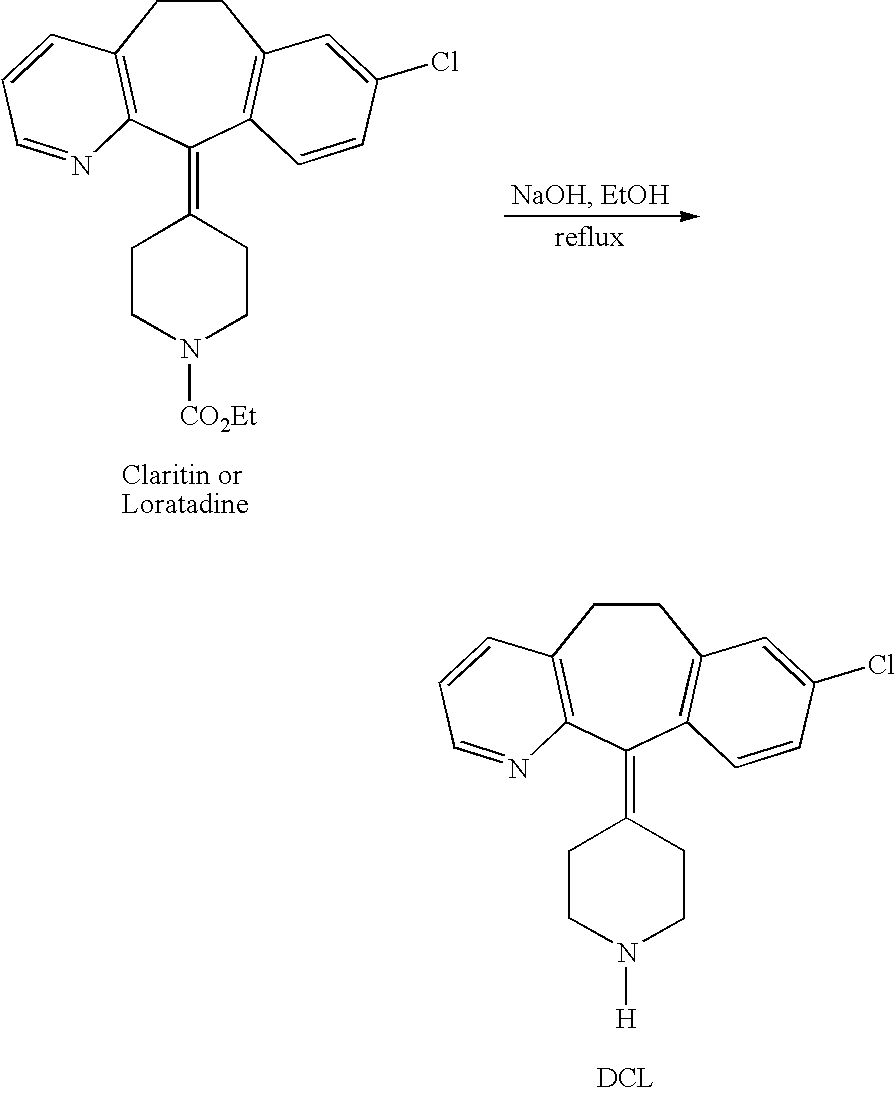Methods and compositions for treating allergic rhinitis and other disorders using descarboethoxyloratadine
a technology of descarboethoxyloratadine and compositions, which is applied in the field of methods and compositions for treating allergic rhinitis and other disorders using descarboethoxyloratadine, can solve the problems of adverse electrophysiologic side effects, similar incidence of fatigue, headache and nausea, and other severe adverse effects, so as to avoid adverse side effects
- Summary
- Abstract
- Description
- Claims
- Application Information
AI Technical Summary
Benefits of technology
Problems solved by technology
Method used
Image
Examples
example 1
4.1 Example 1
Preparation of Loratadine and its Metabolites
[0065] Loratadine can be synthesized by methods disclosed in U.S. Pat. No. 4,282,233. The metabolites are prepared similarly, by reaction steps conventional in the art, as described in U.S. Pat. No. 4,659,716 which is incorporated here by reference in its entirety. One common method of preparing DCL is to reflux loratadine in the presence of sodium hydroxide and ethanol as depicted below.
Extraction of Commercially Available Claritin Tablets (600×10 mg):
[0066] Tablets of loratadine, were diluted with water and chloroform. The mixture was stirred, then filtered through celite, rinsed with chloroform until the filtrate contained no loratadine. The separated aqueous layer was extracted with chloroform twice. The combined organic layer was washed with water, brine and dried over sodium sulfate. The solvent was evaporated to give pure loratadine as a white solid.
Saponification of Loratadine:
[0067] Loratadine (4.0 g) was add...
example 2
4.2 Example 2
Antihistaminic Activity
[0068] The antihistaminic activity of loratadine and DCL were compared in isolated strips of guinea pig ileum contracted with histamine. This preparation is generally accepted by those skilled in the art as predicative of its efficacy as a peripheral histamine H-1 receptor.
Methods:
[0069] Experiments were performed on pieces of ileum taken from male guinea pigs (Hartley strain, 419-560 grams; Elm Hill Breeding Laboratories, Chelmsford, Mass.). The tissues were suspended in tissue chambers containing 40 ml of Tyrode's solution aerated with 95% oxygen and 5% carbon dioxide at 35° C. The Tyrode's solution contained (in mM) 137 NaCl, 2.7 KCl, 2.2 CaCl21 0.025 MgCl21 0.4 NaHPO4, 11.9 NaHCO3 and 5.5 glucose. Contractions in response to histamine were recorded with isotonic transducers (Model 357, Harvard Apparatus Company, South Natick, Mass.) using an ink-writing polygraph (Model 7, Grass Instrument Company, Quincy, Mass.). A tension of one gram wa...
example 3
4.3 Example 3
Receptor Binding Studies
[0077] Receptor binding studies on the binding affinities of loratadine and DCL at histamine H-1 receptors were performed.
[0078] The methods described by Dini et al., which is hereby incorporated by reference herein (Agents and Actions, 33:181-184, 1991), were used for these binding studies. Guinea pig cerebella membranes were incubated with 0.5 nM 3H-pyrilamine for 10 min at 25° C. Following incubation, the assays were rapidly filtered under vacuum through GF / B glass fiber filters (Whatman) and washed several times with ice-cold buffer using a Brandel Cell Harvester. Bound radioactivity was determined with a liquid scintillation counter (LS 6000, Beckman) using a liquid scintillation cocktail (Formula 989, DuPont NEN).
[0079] IC50 values were determined for compounds tested and pyrilamine at the H-1 histamine receptor:
TABLE 3Inhibition of Pyrilamine Binding at H-1 ReceptorH-1 receptorCompoundIC50 (nM)(nH)Loratadine721(1.55)DCL51.1(1.12)Pyri...
PUM
| Property | Measurement | Unit |
|---|---|---|
| resistance | aaaaa | aaaaa |
| pH | aaaaa | aaaaa |
| flow rate | aaaaa | aaaaa |
Abstract
Description
Claims
Application Information
 Login to View More
Login to View More - R&D
- Intellectual Property
- Life Sciences
- Materials
- Tech Scout
- Unparalleled Data Quality
- Higher Quality Content
- 60% Fewer Hallucinations
Browse by: Latest US Patents, China's latest patents, Technical Efficacy Thesaurus, Application Domain, Technology Topic, Popular Technical Reports.
© 2025 PatSnap. All rights reserved.Legal|Privacy policy|Modern Slavery Act Transparency Statement|Sitemap|About US| Contact US: help@patsnap.com


